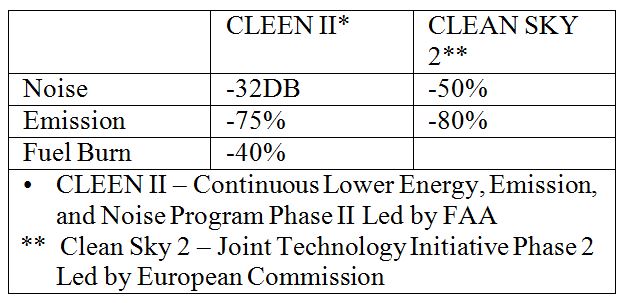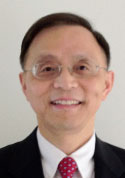Challenges in More Electric Aircraft (MEA)
By Hao Huang, IEEE Fellow, SAE Fellow
Higher Energy efficiency, lower NOx emissions, and lower audible noise for aircraft have become critical issues that need to be addressed due to threats on quality of life and even survivability of our future generations. Recently, significant efforts have been made to address these environmental and resource conservation issues. The following table shows the objectives set by the US Federal Aviation Administration (FAA) and the European Commission for 2020+:

1. Where are we with MEA?
The nature of the More Electric Aircraft (MEA) approach has made itself an integral part of the solution to accomplish the objectives listed in the table above. It is well known that there are two energy sources on conventional aircraft: the primary source that is engines on the aircraft and the secondary sources that are electric, pneumatic, and hydraulic systems powered by the primary source. In the last fifteen years, tremendous progress has been made in MEA, with the most outstanding being the ones on Boeing 787, Airbus 380, and Lockheed F35. These efforts have been mainly focused in the area of the secondary energy sources, i.e. replacing the pneumatic or hydraulic system with an electric on. Traditionally, the pneumatic system is utilized to power the environmental control system (ECS) and the anti/de-icing system, and the hydraulic system is used for flight control actuation, utility actuation, landing gear, etc. Recent research and development indicate that MEA will develop significantly further and progress into innovating the primary energy source. Not long from now, the Brayton law, a physics law governing the primary energy source, will be broken. The turbo engines will become a hybrid of turbo and electric, opening up a new channel to drastically improve engine fuel economy. Furthermore, small electrically driven aircraft have been emerging, and the number of seats will continuously increase along with time. AIRBUS has started to talk about 100 passenger electric aircraft. Prospects of MEA are very promising. However there are still challenges that prevent the aerospace industry to harvest the advantages of MEA.
2. What are the challenges?
One of the major challenges is weight. Multiple studies have shown that MEA can considerably reduce fuel burns, likely pertaining to wide body (WB), narrow body (NB), and even much smaller aircraft. However, MEA is heavier in general with the technologies we have today. In part, this is due to the heavier than expected power electronics box, where the staggering weight of the EMI filters comprises ~25-40%.
MEA is about replacing pneumatic and/or hydraulic with electric, and consequently the electric power demand is much higher than that of a conventional approach. For example, the total electrical power generation on Boeing 787 is above 1MW while a corresponding conventional aircarft uses less than ¼ of the power. Significantly higher electrical power demand challenges the cooling and dynamic control of power generations and conversions.
It should be pointed out that the continuous improvement of power electronics and its associated cooling and controls will continuously bring the weight of these electrical components down. However, in some areas, such as hydraulic flight control actuation, the force density generated by hydraulic can be as high as more than 15 times the force density generated by electric. For this case, the challenge cannot be overcome at the component and box levels.
New power electronics, new cooling, new controls, and new system level design challenge the safety, robustness, reliability, and certification of new MEA. This adds tremendous technical, cost, resource, and schedule risks to the development and investment of MEA.
Given the above mentioned facts, two parallel trends will be apparent in the upcoming decades. One is that MEA is inevitable and irreversible, and the other is that the air framers will squeeze and harvest everything they can to generate the revenues without going too fast and too much further in MEA. Although understandable, it is imperative that we overcome the challenges in order to move forward with MEA.
3. How to overcome the challenges?
Wide Band Gap (WBG) devices, such as SiC or GaN, are part of the solution to address the weight issue due to the nature of their high temperature, low losses, and high switching capabilities.
Reducing the weight and size of EMI filters is critical to the success of MEA. Design optimizations of common and differential mode filters may not get us too far from where we are today. New topologies of the power electronics may be necessary in order to have substantial weight impact in this area.
In the areas where the electric is hardly competing with the pneumatic and hydraulic, the solution is system integrations as well as multi physics discipline integrations. Multiple studies have shown that optimizations at the aircraft level will make the MEA far more attractive than other approaches in terms of weight, size, fuel burn conservation, clean air and noise reduction.
High fidelity real time and hardware-in-the-loop based “virtual copper bird” and/or “iron bird” are very important to address safety, robustness, and reliability maturation challenges for MEA. However, these efforts will never totally replace the actual testing, debugging, and ruggedizing. Main actual copper bird and iron bird labs have been established by main air framers and tier one system suppliers. Significant testing of components, subsystems, and systems must be continuously performed in order to mature the MEA technologies. We cannot avoid the actual testing, so by increasing collaboration we can reduce development cost.
4. What does the roadmap look like?
Looking forward, we are very excited about the future of MEA. In the next couple of decades, there may be three major waves for aerospace industries to capture: The time interval of the first wave is now to 2023, and it is about harvesting the current technologies and their increment advancements in both engines and systems. The majority of the new aircraft programs may be re-engine programs. The time interval of the second wave is from 2023 to 2030, and it is about major technology evolutions in engines and systems. Some new MEA programs may occur, but there will be a substantial amount of uncertainties in this period, requiring us to figure out flexible strategies to cope. The time interval of the third wave is above 2030, and it is anticipated that there will be revolutionary type technology break through, such as breaking the Brayton cycle. At this time, MEA will not only be in the area of the secondary sources, but also in the area of the primary source. In each of the three waves, there will be great opportunities as well as reshaping of the landscape.
 Dr. Hao Huang is the Technology Chief of GE Aviation Electrical Power. He is responsible for technical directions, innovation strategies, multi-generation product roadmaps of the aircraft electrical power division, and he has been constantly leading and involving inventions and innovations of aircraft electrical power technologies. Dr. Huang is an IEEE fellow with citation of “for contributions to electric power generation, conversion, and control in aircraft.” He is also a SAE fellow with citation of “a recognized technical leader in more electric aircraft and electric vehicle power systems.” Dr. Huang received his Ph.D. Degree in Electrical Engineering from the University of Colorado at Boulder, Boulder, Colorado, USA in 1987. He has 30 year experience in Aircraft Electrical Power Systems, Power Generations, Engine Starting, Power Electronics and Controls, and electric vehicle drives. He has had 40 patents (include patent pending), 22 technical publications, and 3 software copy rights in the above mentioned areas.
Dr. Hao Huang is the Technology Chief of GE Aviation Electrical Power. He is responsible for technical directions, innovation strategies, multi-generation product roadmaps of the aircraft electrical power division, and he has been constantly leading and involving inventions and innovations of aircraft electrical power technologies. Dr. Huang is an IEEE fellow with citation of “for contributions to electric power generation, conversion, and control in aircraft.” He is also a SAE fellow with citation of “a recognized technical leader in more electric aircraft and electric vehicle power systems.” Dr. Huang received his Ph.D. Degree in Electrical Engineering from the University of Colorado at Boulder, Boulder, Colorado, USA in 1987. He has 30 year experience in Aircraft Electrical Power Systems, Power Generations, Engine Starting, Power Electronics and Controls, and electric vehicle drives. He has had 40 patents (include patent pending), 22 technical publications, and 3 software copy rights in the above mentioned areas.
About the Newsletter
Editors-in-Chief

Jin-Woo Ahn
Co-Editor-in-Chief

Sheldon Williamson
Co-Editor-in-Chief
TEC Call for Articles 2023 - Advances in Charging Systems
The TEC eNewsletter is now being indexed by Google Scholar and peer-reviewed articles are being submitted to IEEE Xplore.
To submit an article click here.


